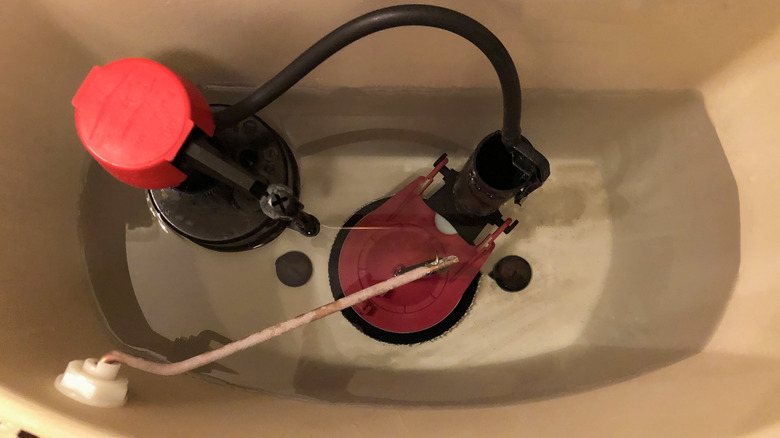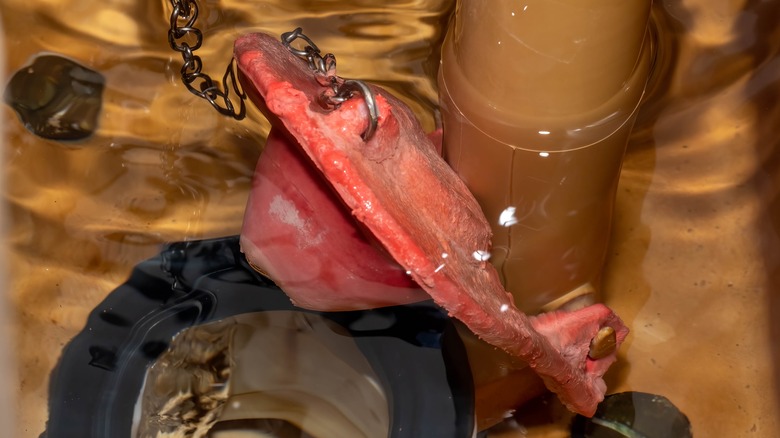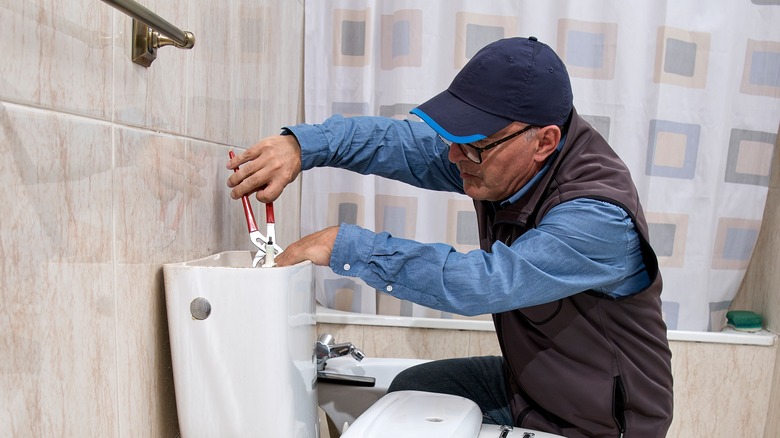How To Recognize Common Toilet Flapper Problems (& Signs It's Time To Call The Pros)
A toilet flapper is a key piece of the appliance's design. A failing flapper is a common reason for leaks, and you should never ignore such problems as they can lead to wasted water and a significantly higher bill. But how do you know if the flapper is causing the problem with the toilet?
We reached out to Chuck Pound, a Frontdoor virtual plumbing expert, for help with identifying the problems related to the toilet flapper. In an exclusive discussion with House Digest, Pound said that simply taking a few seconds to pay attention to the toilet's performance is the best place to start. "The sounds of trickling water in a quiet bathroom are usually the first signs of a failing toilet flapper, as well as movement in the water of the bowl when no one has used it," he said.
If you are having these problems, try to think back to the last time you replaced the flapper. If you can't remember when that was, or if it's been five years or more, Pound said the material in the flapper is probably worn down. "The most common reasons for a flapper to fail are age and the water quality in that area," he said. "As a flapper ages, it becomes soft and will begin to fall apart, leading to leaks. Also, water deposits from the minerals in the water can build up on the parts in a toilet tank, also causing leaks and malfunctions."
How to examine your toilet flapper to recognize signs of problems
According to Chuck Pound, people should check the flapper as part of regular inspections of the toilet or when performing simple cleaning or maintenance tasks. "It is a good preventive maintenance rule to remove the tank lid of your home's toilets at least once a year and inspect the insides," he told House Digest exclusively.
When you are looking at the interior of the tank, pay attention to things like slime buildup on its sides. This material indicates that you may need to add chlorine tablets or a little bit of bleach to the water. If you have slimy water, look for discoloration on the parts in the tank. If the flapper has discoloration, run a quick test to see how it's performing. "Give it a flush and watch how the water flows out and the flapper closes," Pound said. "Pay attention to the timing of the flapper closing and that it allowed the water to drain out for a full flush."
Beyond inspecting the flapper itself, pay attention to all the parts inside the tank. A toilet that looks old with aged parts inside the tank may need more than just a flapper replacement. "If taking the flapper off causes brittle plastic parts to start breaking inside the tank, then a full replacement or rebuild may be needed," Pound said.
When replacing the flapper is a DIY project and when you need a professional plumber
If you've determined that your toilet flapper needs to be replaced, the question is whether you can do the work yourself or if you should call a plumber. Pound told us that many people can replace the flapper as a DIY job. But if the work will require replacing more parts than just the flapper, it may be time to seek help from a plumber.
Pound said finding the right replacement model for the flapper is an important part of the job. "In most cases, you can simply get a standard flapper from the local hardware store and replace it in minutes," Pound said in an exclusive interview with House Digest. If you're nervous about buying a flapper that's compatible with your toilet, Pound suggests taking a picture of the interior of the tank. If you can see the toilet's model name or model number, which may be printed inside the tank, take pictures of these, too. Then, you can ask the store's employees to help you find the right replacement part.
Finally, hiring a plumber may be necessary if you have other issues beyond the flapper, such as a faulty water valve. "If you shut off the water valve to the toilet and the water is still filling into the tank, then you may need to replace the shut off valve first, which could be a more skilled repair than most would care to try," Pound said.


